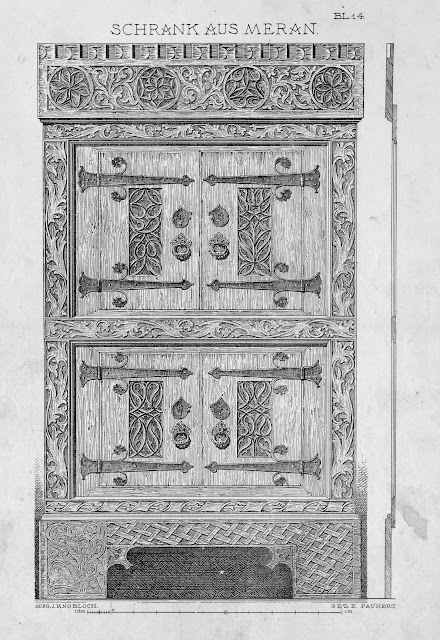In this post I would like to show some more furniture pieces from the plates in the books 'Die Zimmergotik in Deutsch Tirol' by Franz Paukert. As previously mentioned, due to my scanner size limit each plate consists of two scans that are 'glued' together.
The bench (with turnable backrest) and the chest, two works of Tyrolean joinery that are already being sought out of the country, are shown with the use of dimensional sketches and photographs made available to the publisher by Mr. Ueberbacher from Bolzano, Italy.
These two folding chairs are in the Figdor collection in Vienna. One
of them (Figure A), coming from Bozen, shows the old, quilted leather
seat belt and its shape is reminiscent of the faldistorium of the
women's monastery on the Nonnberg near Salzburg. The
armchair of Figure B, like the previous one, has crossed legs but with
partially suspected monkey- and crab-like knobs and comes from St. Michael
in Eppau. (The Figdor collection was auctioned in the early 20th
century; the auction catalogues can still be found in second hand book
stores)
Noteworthy
is the simplest possible treatment of the tracery fillings in the wash
basin: flat cuts with a coloured background, as well as the extremely
simple construction of the box, which is common to almost all of this
type of Tyrolean Gothic furniture; Jointed
boxes with decorative strips placed in front of them on jointed feet
and finally the almost continuous painting of the ornaments or at least
the flat base of the carved parts. Castello Principesco, or Landfurstliche Burg, Merano, Italy.

A chest owned by the bookstore owner F. Plant in Merano. In spite of its extremely simple structure and in spite of its decoration reminiscent of the Romanesque period, it was found to be of a rather late origin and proof that the Tyrolean gothic art did not reluctantly fall back on very early roots. The lid of the cest is not connected to the other part of the chest by iron hinges, but by wooden pegs which function as axes of rotation, and go through the lateral gripping strips and the sides of the chest.
Among the increase in the number of furniture pieces of the Landfurstliche Burg in Merano over the last few years, the furniture shown in whole or in part on the plates above and below is the most important. The legs of the chests belong to the box, which differs little from the already known pieces of a similar kind and only in the ornaments and the exposition of the fields on the front.



















